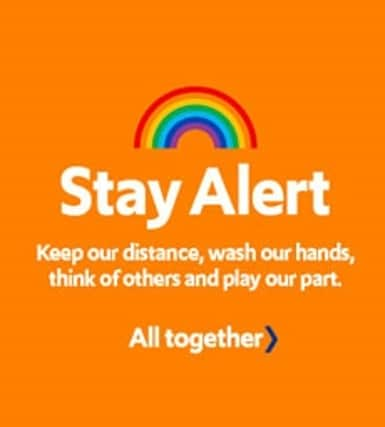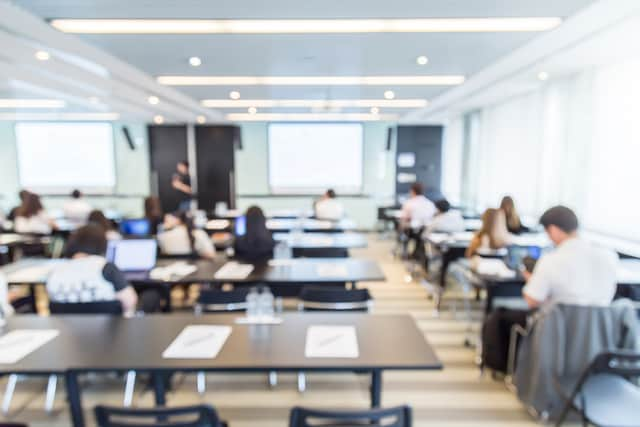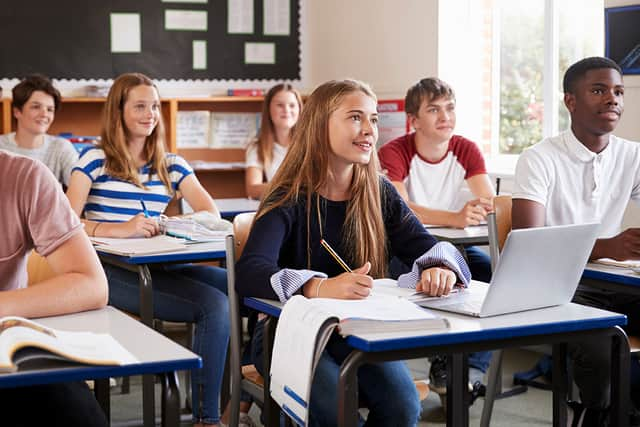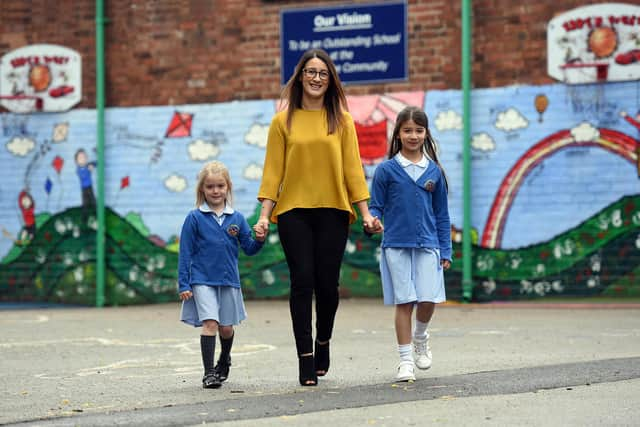Pupils welcomed back into their classrooms


HOW DOES SCHOOL DIFFER NOW?
" No more than 15 children per classroom
" Pupils asked to stay 2m apart where possible
" More regular hand washing
" Staggered break and lunch times, plus different arrival and departure arrangements
" Less sharing of equipment such as books and toys
" Parents should not gather at school gates
" Carers should only enter school buildings by appointment
CASE STUDY 1
HINCHINGBROOKE
Advertisement
Hide AdAdvertisement
Hide AdAt Hinchingbrooke School on the outskirts of Huntingdon in Cambridgeshire, principal Mark Patterson has welcomed back Year 10 and Year 12 pupils. The students, who will be doing their GCSEs and A-levels next year, have returned to a very different school from the one they last saw in March.
The school, which is part of the ACES Academies Trust, is operating on a rota system. Year 12 has been split into two groups - one group comes in on a Monday, and the other comes in on a Tuesday.
Year 10 has been split into three groups. One group is attending school on Wednesday, another on Thursday and one on a Friday.
Mr Patterson said: "While it's important for everyone to be back at school, it's clear you have to prioritise those students who are nearer to their national examinations because they're the first ones who'll be tested externally next year.
Advertisement
Hide AdAdvertisement
Hide Ad"Giving them some face-to-face time before the summer is crucial. Familiarising them with school again shouldn't be underestimated." It's straight back into business as usual for the Year 12s, who have been given their A-level lessons from the off.
Whereas Year 10s will have Personal, Social, Health and Economic lessons on their first day back at school, before going into the usual English, Maths and Science. With lots of debate surrounding whether children should return to school or not, Mr Patterson is keen to point out that even the best online learning systems do not compare to being in the classroom with a teacher.


He said: "They've been out a long time and remote learning is not nearly as good as face-to-face learning. We know that from research and we know that from our experience as well."
And while some parents are divided over the prospect of sending their children back to school, others are clearly in favour of going back to school.
Advertisement
Hide AdAdvertisement
Hide AdAlesia Dickinson, a parent to two Year 10 students, said: "They've got hand sanitising stations, one-way systems, the teachers are making sure everyone is social distancing.
"The communication school provided has reassured parents and I don't feel any concerns now compared to how I did before."
Mr Patterson added: "Students are children - it's very hard for them to motivate themselves in a disciplined way all day every day. That structure is crucial to them all."
Student Rheeya Makwana, who is 17, said: "I was so happy when I was told we were going back to school because I really enjoy lessons.
Advertisement
Hide AdAdvertisement
Hide Ad"We've been having online lessons and voiceover PowerPoints, but it's not really the same as being in a classroom. The structure was really good and I felt like I learned a lot more being back at school. I came home in such a good mood.
"It was obviously quite different being two metres away from everyone, but they still tried to teach as we normally would so it wasn't too different other than that."


'Lovely to hear children playing and see schools vibrant again'
CASE STUDY 2
EMBARK FEDERATION
For staff across the Embark Federation's nine schools in Derbyshire, welcoming Reception, Year 1 and Year 6 pupils back was an event they'd been working towards since lockdown was announced in March.
Advertisement
Hide AdAdvertisement
Hide AdEmbark Trust leader Matthew Crawford said: "It's lovely to hear the children playing and see schools becoming vibrant again.
"As soon as lockdown began we started work on our Reconnection to Recovery and Resilience programme, a nine-stage support package to welcome children back safely.
"We're following the government guidelines but in a way that's fun for the children - for example, we aren't marking big Xs on the floor to show them where to go but, in some schools, painting snakes in bright colours.
"And we're not ploughing straight back into Maths and English - we wanted to meet the children's needs creatively when they returned before moving into a more formal curriculum."
Advertisement
Hide AdAdvertisement
Hide AdMost Embark schools are now back at around 25 to 30 per cent capacity, up from around two per cent when they were just welcoming vulnerable children and those of key workers.
For example, over the past few weeks, Richardson Endowed Primary in Smalley, Derbyshire, has seen 53 of its 210 pupils walk back through its doors.


WE'RE BACK: Vicki Ellis with daughters Darcey, left, and Amelia.
Headteacher Kate Mason said: "I get calls every day from parents who want their children to return. The parents all talk to each other so they're hearing positive stories about children returning and that's spreading confidence.
Advertisement
Hide AdAdvertisement
Hide Ad"Parents' biggest concerns are around children's mental health and wellbeing - they're worried their children will come back to an environment that's nothing like school, particularly the younger ones who are used to a play-type atmosphere and are now sitting at single desks. But our teachers have made the changes fun.
"I tell parents we're offering a First Class service - smaller class sizes as it's maximum 15 in a bubble, new equipment for every child that's cleaned when it's been used." And, to celebrate the new bubble groupings, the children were all given bubbles to blow in the playground. Each bubble has a different colour. Eight-year old Amelia Ellis, in Year 3 at Richardson Endowed, is in the green bubble while her little sister Darcey, Year 1, is in the orange. Amelia said: "I wanted to go back to school and see my friend and teachers. I'm a homework monitor so I'm allowed to stay in at break times and help. I check everyone has done their homework but I'm not very strict."


PLANNING A HEAD: Embark Trust leader Matthew Crawford.
Social interaction vital - psychologist
Children returning to school will find themselves in a very different environment to the one they left behind when lockdown was introduced in March.
Increased hand hygiene and cleaning, the creation of "bubbles" so children only mix with a select group, staggered start and break times, classroom assemblies and one way systems have all been introduced to help minimise contact.
Advertisement
Hide AdAdvertisement
Hide AdPsychologist and University of East London lecturer Dr Sam Wass says that while there will certainly be a degree of adjustment for children, there are also a huge number of positives to returning to school, as well as simple ways to support them. He said: "Obviously, one of the most important things that children get by going back to school is social interaction. "When a child is stuck at home interacting with an adult there's always an asymmetry - one is always the child and one is always the adult.
"Whereas with peer-on-peer interactions - children arguing over who gets to be the captain in the game, who gets to be friends with who - there isn't that asymmetry.
"Nobody gets to decide, nobody's special because they're younger or older. It's a competition amongst equals."
Dr Wass says this gives children an opportunity to vital develop social skills.
Advertisement
Hide AdAdvertisement
Hide AdHe said: "That's when they have to work hard at learning how to be persuasive, how to stand up for themselves. We know that children who are more socially isolated tend to have lower subsequent education attainment, so it's a really important part of the school experience."
Dr Wass also points to the importance of stability and routine, which, despite parents' best efforts, may have been affected during lockdown.
Check with your Local Authority for the latest news on schools opening in your area.